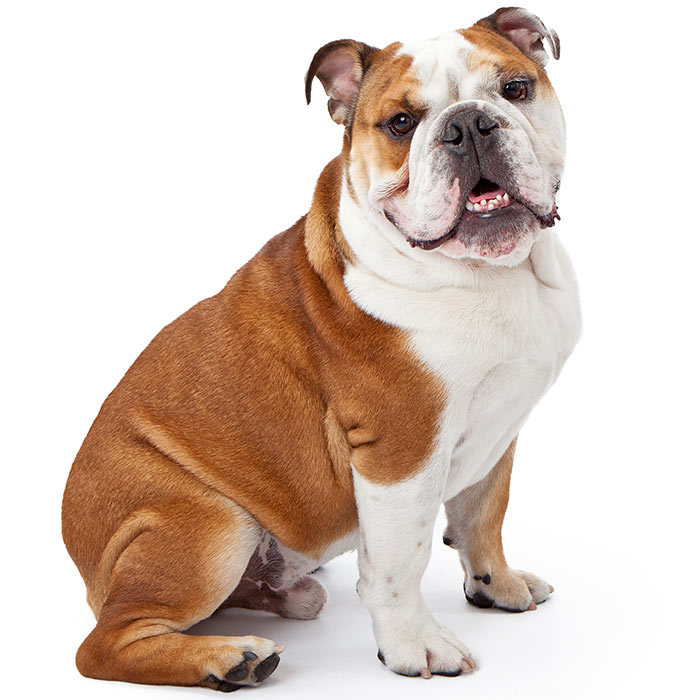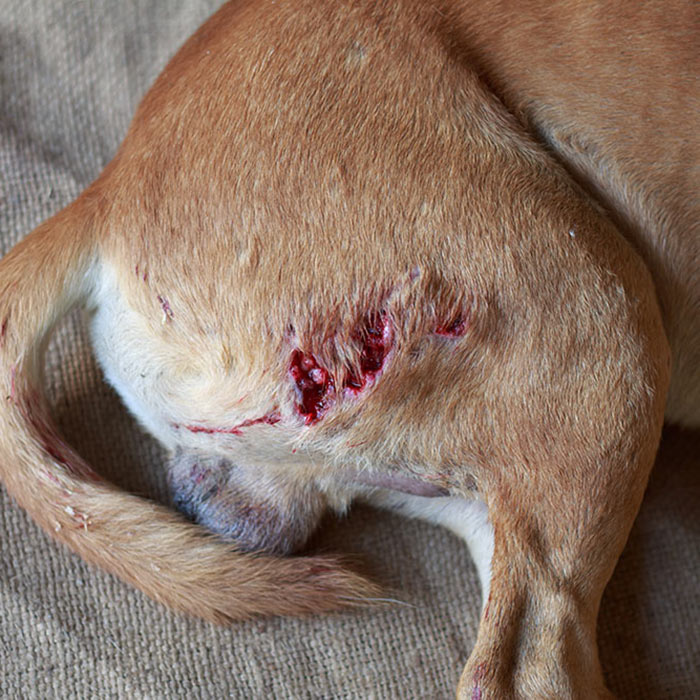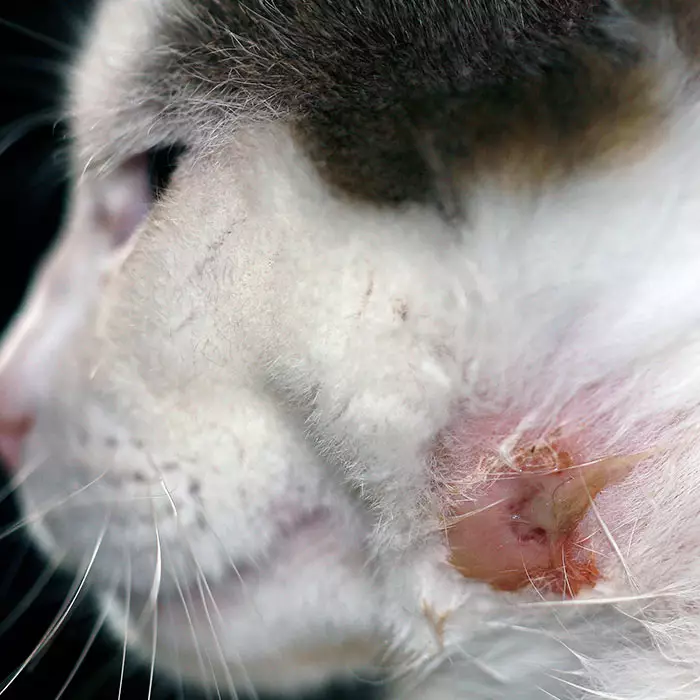Bite injury in cats and dogs
What is a bite injury?
A bite injury is a wound, usually a break in the skin, caused by the teeth. Bite injuries to dogs and cats from other animals can range from mild to moderate to severe. The head, neck and legs are common sites of bite injuries. Vital structures in the neck, including the jugular vein and the carotid artery, numerous nerves, the oesophagus, and the trachea are easily injured by a bite. Bites on the face can cause severe damage to the eyes, ears and mouth, while bites to the legs can cause damage to the joints.
Bites from a dog can result in serious injury to the skin and soft tissues of the victim. A dog’s jaws and teeth are very powerful and can crush or tear muscles and skin, penetrate through the chest wall and injure the lungs, or cause serious or fatal damage to intestinal organs. Even a bite that does not break the skin can cause crushing or bruising to the underlying soft tissue. Cats’ teeth are very sharp, hence cat bites are very likely to puncture the skin.
Because an animal’s mouth contains bacteria, sharp teeth that perforate the skin will introduce bacteria, or other infectious organisms, into the wound where they can multiply and spread, causing infection. Therefore, it is important to regard all bite wounds as serious. If left untreated, the bacteria in an infected bite wound can cause an abscess at the site or it can spread into the surrounding area, causing cellulitis, or infection of the tissue. In rare cases, a bite wound can cause septic arthritis (infection of the joint), osteomyelitis (infection of the bone), pyothorax (pus in the chest cavity) or septic peritonitis (pus in the abdominal cavity).
Bite injuries are a common reason for emergency appointments with veterinarians. Some estimates suggest that dog bite wounds account for about ten percent of the traumatic injuries routinely presented to veterinarians. While cats are may be the victim of bites from other cats or from dogs, they not appear to be as frequently bitten as dogs. In a retrospective study of dog bite wounds in 185 dogs and 11 cats, it was found that male dogs were more frequently bitten than females, and small dogs weighing 10 kg or less were the most common bite victims and most likely to suffer multiple injuries.
Cost of wounds from fights or bites for dogs and cats
Wounds from fights or bites were the fourth most common health issue experienced by both dogs and cats in 2024, according to PetSure claims data. Where possible, keep cats indoors in a cat friendly enclosure and when introducing them to new cats, do so carefully and with caution.
| Claims data for wounds from fights or bites | Average cost of treatmentØ | Highest cost of treatmentØ |
| Dogs | $836 | $46,525 |
| Cats | $620 | $24,529 |
ØBased on PetSure claims data, 2024 calendar year. Reimbursement for these claims under a pet insurance policy would be subject to limits, such as annual benefit limits or sub-limits, benefit percentage, applicable waiting periods and any applicable excess. Cover is subject to the policy terms and conditions. You should consider the relevant Product Disclosure Statement or policy wording available from the relevant provider. Please note that values calculated are based on all claims for that condition and medically related conditions in each calendar year.
Because it is difficult to predict the costs of veterinary care, it can help to have measures in place to help prepare for the unexpected. Pet insurance can help by covering a portion of the eligible vet bill if the unexpected does happen.
Get a quote for 2 months free pet insurance for your puppy or kitten in their first year.
Symptoms of bite injuries in dogs and cats
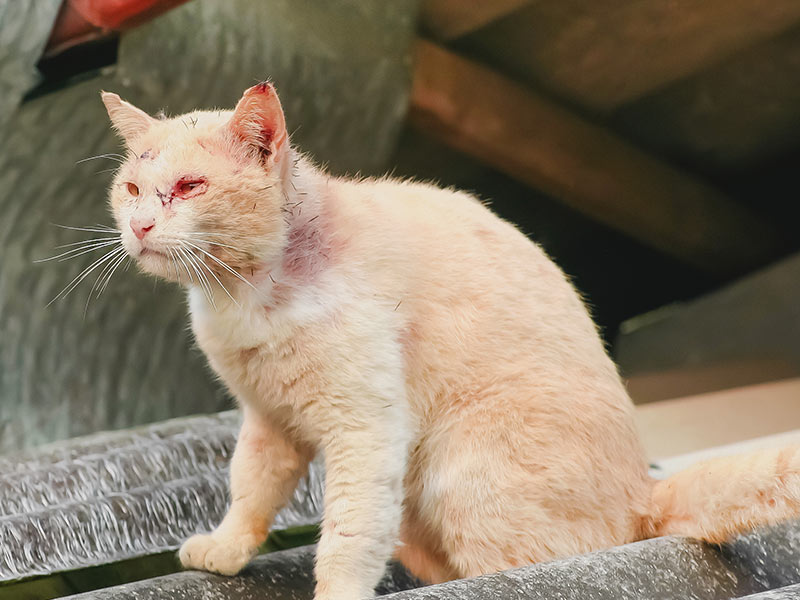
A bite injury can range from a tiny nick on the skin to a serious, penetrating wound. However, even a barely visible bite wound can cause damage to the underlying tissue, such as internal bleeding or nerve damage.
Symptoms of bite injuries may include:
- An open wound (which may be obscured by fur)
- A puncture to the skin
- Bleeding
- Reluctance to be touched or held
- Raised bump or abscess at site
- Fever from infection
- Loss of appetite
There are certain symptoms that require immediate emergency treatment. These include:
- Uncontrollable bleeding (bleeding that can’t be stopped)
- Breathing difficulty
- Weakness
- Continuous crying or whining from pain
- Limping
- Pale or blue gums
- Vomiting
- Lethargy, from pain or infection
- Collapse
Causes of bite injuries in dogs

Bite injuries to dogs are most likely to occur when interacting with strange dogs in an uncontrolled setting, such as running free in parks. However, it is not only unfamiliar animals that bite; a fight with a co-habiting dog may result in a bite. Obviously bites from larger dogs are often more impactful than from smaller dogs and the result can be more serious, but it is not only large dogs that bite and even a small dog can cause significant damage to another animal.
In puppies, biting is often part of aggressive play. In adult dogs, biting and other aggressive behaviours can have multiple underlying motives or causes. Aggressive behaviours include growling, baring the teeth, lunging, snarling, nipping or biting; these behaviours may be used for communication or to deal with competitive issues and perceived threats. Competition between dogs may occur over food, territory, attention of an owner, position in a pack or group, or a protective reaction towards another dog.
Causes of bite injuries in cats

In cats, a bite wound usually occurs as a result of a fight or rough play. Even usually friendly cats can get into an altercation with another cat, dog or other domesticated or wild animal. Co-habiting cats can have disputes over food, toys or a favourite sitting spot and resort to the use of teeth and claws.
A cats’ teeth are particularly sharp and can penetrate easily into flesh, making even brief flare-ups between cats a potentially dangerous experience. A quick but penetrating bite can allow bacteria from the mouth to enter the tissues under the victim’s skin. If the resultant wound bleeds freely and easily, the bacteria can be flushed out of the tissues along with the blood. However, if the wound seals up quickly or is more of a puncture than a tear, bacteria can remain in the tissues, causing an infection-filled sac, or abscess, to form.
Unsure how serious it is?
Bow Wow Meow policyholders can get access to trusted vet care anytime, anywhere, at no additional cost. Connect to an experienced Australian registered vet via video call, 24/7. Whether it’s providing vet advice, setting up at-home treatment plans, or confirming if you need to visit a vet in person, you can get help when you need it.
Find out more about our pet insurance cover options.
How are bite injuries in dogs and cats diagnosed?
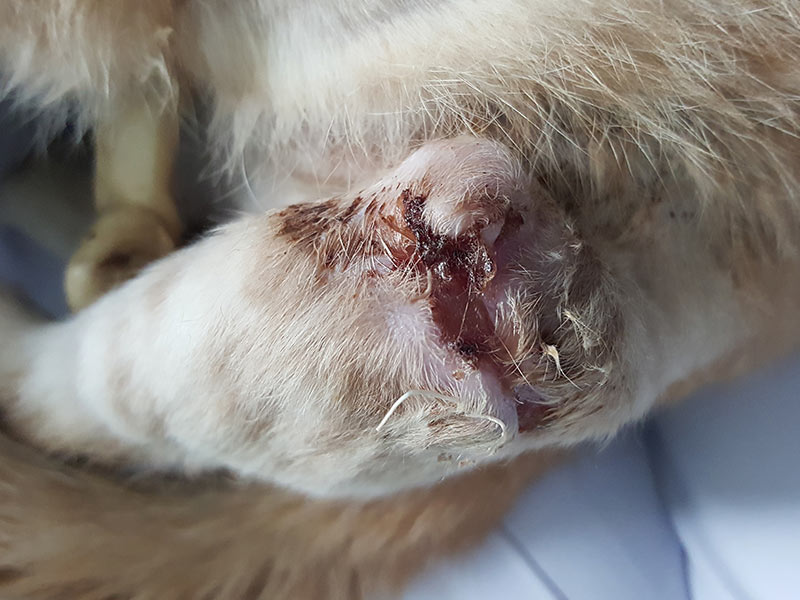
While larger injuries obviously require medical attention, even smaller wounds that appear to be minor can create large, and even life-threatening, health problems if not properly treated. It can be difficult to determine the extent of the injuries sustained, particularly if the wounds are located in heavily furred areas of the body. Small puncture wounds from canine or feline teeth can close over rapidly and can easily be missed. Therefore, if an animal has suffered a bite wound, immediate veterinary care is essential, regardless of the perceived severity.
Diagnosis of a bite wound will rely primarily on the history provided by the owner. It is important to provide the vet with as much information as possible, including:
- The approximate time frame of the bite wound and the appearance of symptoms.
- Whether the animal is up to date on its immunisations, to rule out the potential spread of any infectious diseases as a result of the bite.
- If a cat, whether it is an indoor or outdoor cat.
- The vaccination status of the aggressor, if possible.
The vet will conduct a thorough physical examination of the animal, in order to:
- Determine the severity of the initial bite wound.
- To search for any additional wounds that may be hidden by fur, which may require shaving the fur.
Prognosis
The prognosis for bite injury in dogs and cats depends on many factors, including the severity of the wound, the promptness of diagnosis and treatment and the age and overall health of the animal. Another important factor is the area of body that sustains the injury, with mortality occurring more frequently where the bite is to the thoracic (chest) and abdominal areas. While minor injuries to the mouth and nose are likely to heal quickly, bites to the neck or legs can have more serious complications. However, in most non-life threatening cases, the animal should make a complete recovery with prompt and proper treatment.
Treatment for bite injuries in dogs and cats

The veterinarian will determine what sort of treatment is necessary, based on the severity of the injuries, the animal’s general health and the location of the wound. The goal of treatment is to reduce the severity of any infection that develops. This will be achieved by cleaning the wounds, removing any dead or severely damaged tissue, and surgically closing the wounds if possible.
Antibacterial therapy
 Even a tiny puncture that penetrates the skin is at risk of infection from bacteria introduced by the teeth. Antibiotics can prevent cat or dog bite infection or halt the spread of an infection in the case of an abscess. The sooner antibacterial therapy begins after a bite injury, the sooner an infection will be brought under control. Wounds that are treated within six hours of the injury have the best chance of healing without complications.
Even a tiny puncture that penetrates the skin is at risk of infection from bacteria introduced by the teeth. Antibiotics can prevent cat or dog bite infection or halt the spread of an infection in the case of an abscess. The sooner antibacterial therapy begins after a bite injury, the sooner an infection will be brought under control. Wounds that are treated within six hours of the injury have the best chance of healing without complications.
Therefore, for all wounds that have penetrated the skin, precautionary treatment to avoid infection and abscessation will usually include:
- Broad-spectrum antibiotics
- Flushing the wound with an anti-bacterial solution
- Topical antibiotic cream or ointment for minor injuries or wounds that must be left open to heal
If the animal does not respond well to broad-spectrum antibiotics, bacterial culture and sensitivity tests should be performed to determine which bacteria are present and the best antibiotics to treat them.
Additional treatment
- Bite wounds are usually very painful; the vet may administer pain medication or a sedative or anaesthetic before attempting to assess the extent of the injuries.
- The fur surrounding the wound may be shaved to lessen the potential for further contamination and provide better access to the site.
- The wound may be thoroughly cleaned and flushed to remove any contaminants and debris.
- For extensive or severely contaminated wounds, or wounds in sensitive areas of the body (such as near the eyes, mouth or ears), a general anaesthetic may be administered so that the area can be safely and thoroughly cleaned and treated.
- Small puncture wounds will usually be left open so that any infection can drain out.
- Large lacerations will be sutured (stitched).
- Temporary draining tubes may be inserted if the damage is extensive or if there is a risk that fluid will build up in the area.
- Most lacerations will be ‘debrided’ (any infected or compromised skin tissue will be cut away and the edges of the laceration will be trimmed).
- Skin wounds maybe enlarged to allow the underlying tissues to be thoroughly examined and cleaned.
- Abscessed may be lanced so that bacteria and infected fluids can drain away.
- X-ray or ultrasound may be used to look for broken bones or contusions or to see if the bite has perforated the chest cavity or abdominal cavity.
- Quarantine and/or a rabies vaccine booster may required, depending on the vaccine status of the aggressor.
On-going care and management
With appropriate follow-up care and adherence to the recommended course of medications and wound care, the animal has an excellent chance of a full recovery from their bite wound injury. On-going care and management after a bite injury may include the following:
- If the wound has been closed with sutures, you will need to keep the area clean and dry.
- If the wound has been left open to heal, or if a drain is inserted in the wound, you will need to regularly clean away any draining material.
- If the animal has had stitches or a drain tube, a follow up procedure will be required in order for these items to be removed.
- Ensure that the animal is kept comfortable and quiet to promote healing.
- The animal may need to wear a cone or other appropriate limiting device to prevent licking, scratching and grooming of the wound site.
- Do not allow your animal to roam freely and keep your dog on a tight leash when you are outdoors, especially if you are in a park.
- Be aware of behavioural changes in your animal after suffering from a bite wound, such as being fearful or aggressive around other animals.
In summary
A bite injury in a dog or cat can range from a tiny nick on the skin to a serious, penetrating wound. The seriousness of a bite injury should not be underestimated; a barely visible bite wound can cause damage to the underlying tissue and a small puncture of the skin can result in a serious dog bite infection. Sever injuries to the thoracic and abdominal areas can be fatal in some cases. Therefore, all bite wounds should be assessed by the veterinarian as soon as possible.
Treatment for a bite injury will typically include a broad-spectrum antibiotic to lessen the chance that a serious infection will develop. The vet will assess the wound and determine whether additional treatment is necessary, such as debriding the wound or administering sutures. Bite injuries can be life-threatening if left untreated; however, in most non-life threatening cases, the animal should make a complete recovery with prompt and proper treatment.
Bow Wow Meow Pet Insurance can help protect you and your pet should an unexpected trip to your vet occur.
- Find out more about our dog insurance options
- Find out more about our cat insurance options
- Get an instant online pet insurance quote
Bow Wow Meow is proud to have been awarded winner of Canstar’s ‘Most Satisfied Customers’ Award in the Pet Insurance category for both 2024 and 2025!
Bow Wow Meow is proud to have been chosen as Product Review’s Pet Insurance Award Winner every year from 2018 to 2025! This is based on 2,995 independent customer reviews (as at 21/01/2025), with an overall rating of 4.3*
Google Review rating = 4.5* (based on 968 reviews)
Trust Pilot rating = 4.6* (based on 531 reviews)
Bow Wow Meow is proud to have been chosen as Product Review’s Pet Insurance Award Winner every year from 2018 to 2025! This is based on 2,995 independent customer reviews (as at 21/01/2025), with an overall rating of 4.3*
Google Review rating = 4.5* (based on 968 reviews)
Trust Pilot rating = 4.6* (based on 531 reviews)
Bow Wow Meow has been chosen as a winner in the Finder Pet Insurance Awards 2024. Finder’s panel of experts analysed over 140 quotes to award our Ultimate Care Plan the winner of the “Pet Insurance – Value” category.
More information
- https://vcahospitals.com/know-your-pet/bite-wounds-in-dogs
- https://www.petmd.com/dog/emergency/accidents-injuries/what-do-when-another-dog-bites-your-dog
- http://www.pethealthnetwork.com/dog-health/dog-diseases-conditions-a-z/dog-bites-don%E2%80%99t-underestimate-serious-injury
- http://www.pethealthnetwork.com/cat-health/cat-diseases-conditions-a-z/cat-bites-don%E2%80%99t-underestimate-serious-injury
- https://wagwalking.com/cat/condition/bite-wounds
- https://www.ncbi.nlm.nih.gov/pubmed/11958467







